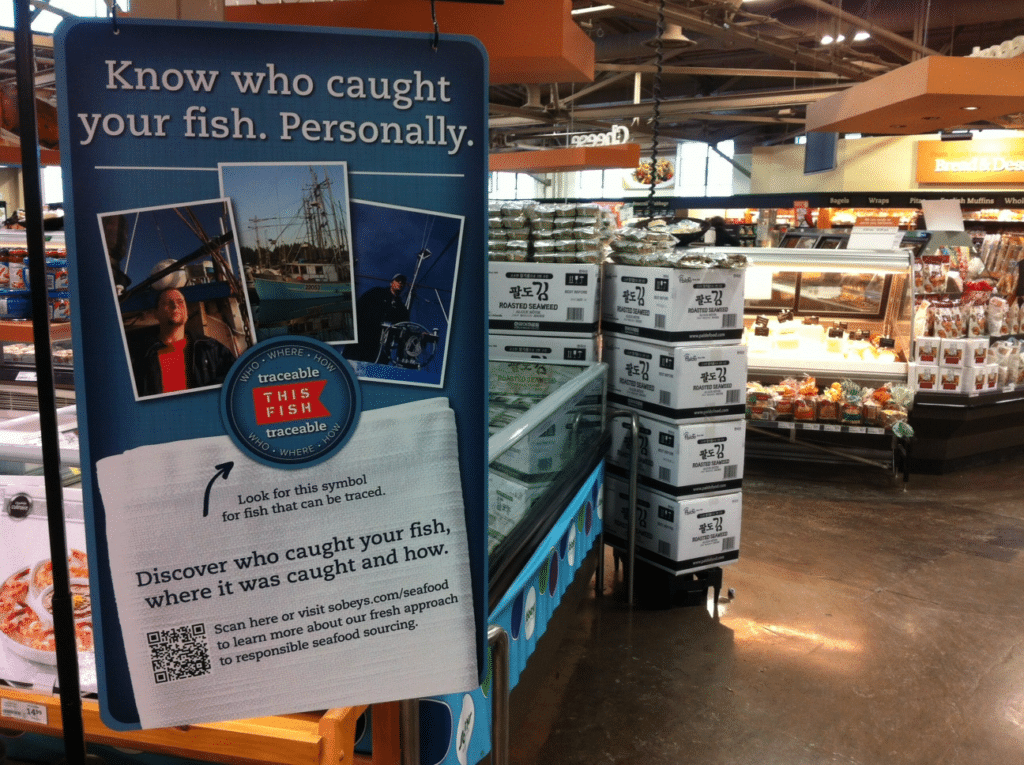In 2011, I was part of the team that launched ThisFish as a consumer-tracing app in a national marketing campaign with Sobeys, Canada’s second largest supermarket. It was an innovative campaign with viral videos, social media and even a national “Trace and Win” contest with cash prizes. Shoppers could trace a code, discover the story of their seafood and even message their fish harvester.
“We’ve seen an amazing number of people viewing the video and had a lot of really good comments on it as well,” said David Smith, Sobey’s Vice President of Retail Strategy and Sustainability at the time. “And the sales of those traceable items in stores are moving pretty well.”
The Retail Council of Canada honoured Sobeys with an Excellence in Retailing Award for the campaign, which included its private label Compliments brand.
Despite its success in social media, awards and sales, the initiative never survived its pilot stage. The reasons were two-fold.
First, unlike Whole Foods at the time which mandated suppliers to use Trace Register’s platform, Sobeys made electronic traceability optional for its suppliers. Most seafood processors were suspicious—even fearful—of this level of transparency. Only a few brave souls came onboard. A shortage of traceable fish caused pricing and fulfilment problems.
Second, antiquated and paper-based traceability systems made it difficult to share data from fishing vessel to retailer. Even the supportive suppliers found that the intensive, manual data collection drove up labour costs. Data errors were common too.


Sobeys weren’t alone. We experienced these scaling challenges in many pilot projects all over the globe: mangrove crab in the Amazon, Chilean rock lobster, artisanal yellowfin in Indonesia, Pacific halibut, Atlantic lobster and so on.
By 2016, we decided to pivot, launching Tally the next year which refocused our traceability efforts on our customers’ internal business needs, such as costing, processing yields and inventory. We went from award-winning marketing to building back-end data infrastructure. I now unglamorously call ourselves “digital plumbers,” laying the pipes to enable data to flow in seafood supply chains.
Nowadays, few technological hurdles prevent traceability back to fishing vessels or farms, given the hundreds of millions invested in digitization, electronic monitoring, VMS, supply chain traceability and other related technologies. Industry attitudes have proven harder to change, but they are changing.
The growth of online shopping, the launch of many direct-to-consumer brands, and rising consumer demand for authentic and responsible products has created a boon in traceable products, from fashion to food.
Market surveys show that consumers value transparency. In fact, we conducted our own consumer surveys, and the results were clear: consumers perceive traceable products to be more sustainable, local and trustworthy. And there’s a willingness to pay more.
Since many of our customers—including seafood processors, distributors and traders—are running our best-in-class traceability Tally software, we’ve decided to relaunch our consumer tracing app. TallyTrace, as we’ve branded it, enables seafood producers to easily share the story of their seafood with B2B customers or consumers.
With the click of a button, you can decide what data you want to share. There’s no redundant data entry and no additional labelling, since it’s fully integrated into Tally’s production and supply chain platform. Consumers simply scan a QR to discover their seafood’s story.
Many of our current customers, recognizing the competitive advantage of a strong digital traceability system, now see marketing opportunities to differentiate themselves from faceless commodities.
At ThisFish, it’s about providing value-added data products for our customers. Once you’ve digitized your data to improve operations, we can extract more value from this data through business intelligence tools, AI and now TallyTrace for marketing. As a company, we are now back where we started from.




